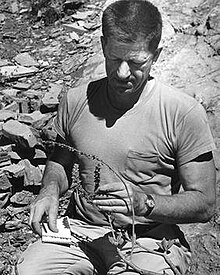|
Reid Venable Moran
Reid Venable Moran (June 30, 1916 – January 21, 2010) was an American botanist and the curator of botany at the San Diego Natural History Museum from 1957 to 1982.[1] Moran was the world authority on the Crassulaceae, a family of succulent plants, and in particular the genus Dudleya, the subject of his Ph.D. dissertation. He named at least 18 plants new to science — some in that family and some not — and published many papers elucidating relationships within the Crassulaceae. As a mark of the respect he earned among his peers, more than a dozen plants have been named for him. Jane Goodall described Moran as "a sort of living myth in botanical exploration in Baja California and the Pacific Islands of Mexico," citing specifically his analysis of the environmental impact of introduced species (especially goats) on the flora of Guadalupe Island.[2] BiographyEarly lifeBorn in Los Angeles, California on June 30, 1916, to Edna Louise Venable and Robert Breck Moran (a petroleum geologist),[3] Moran was raised in Pasadena. By 1932, 16-year old Moran was noted as a "discriminating young collector" of Dudleya. A now invalid species of Dudleya known as Dudleya moranii was named after him.[4] He received his B. A. from Stanford University in 1939 and his M. S. in botany from Cornell University in 1942 before his studies were interrupted by World War II.[1][5] Military careerMoran served in World War II as a second lieutenant in the United States Army Air Forces from 1942 to 1946, his enlistment interrupting his studies at Cornell. By 1944, Moran served as a navigator on a B-24 Liberator in the 515th Bombardment Squadron during the Big Week raids. On the 23rd of February, Moran's aircraft was shot down over Steyr,[6] Austria on its first mission, but the crew had managed to complete their bombing run and bailed out over German-controlled Yugoslavia. Moran was rescued by Yugoslav partisans and managed to return to friendly territory in Italy after 6 weeks with the rest of his crew, collecting plants on the way.[1][5][7][8] On his way back to the United States, Moran passed through Algeria and Morocco, visiting the French botanist René Maire, at the time the authority on Algerian and Moroccan plants. Moran collected plants and Maire assisted with identification and gave Moran tours of the local botanic gardens. Moran later stopped in Dakar and Brazil before making his way back to the United States, returning with 350 herbarium specimens. By September of 1944 Moran was assigned as an Assistant Research Officer in the AAF Instructor's School at Selma, Alabama. Moran was discharged in 1946.[1][7][8][9] Later lifeAfter service in World War II, Moran worked at the Santa Barbara Botanic Garden for a year and a half, but left when he was expected to become its next director, as he found the position too restrictive.[8] Moran went on to receive his Ph.D. in botany from the University of California, Berkeley, in 1951. His doctoral dissertation was titled "A Revision of Dudleya (Crassulaceae)."[10][11] He then went on to join the Bailey Hortorium at Cornell, and then left to join the University of California's Far East Program teaching biology to military personnel in Korea, Japan, the Philippines and Okinawa. While there, Moran spent time collecting specimens of Crassulaceae and sending them to Charles H. Uhl at Cornell for cytology. After his time in Asia, Moran was hired by his longtime collaborator George Edmund Lindsay, who by then was the director of the San Diego Natural History Museum, as the curator of botany. Moran worked as curator from 1957 to 1982.[7][8] As curator of botany, Moran traveled the Baja California Peninsula and its surrounding islands extensively, visiting Guadalupe Island numerous times and exploring the peninsula via car, mule, or by foot. During his time at the museum, the number of specimens in the herbarium increased from 44,000 to 108,000, the majority being Moran's.[7][8] In 1996, Moran published the Flora of Guadalupe Island, a culmination of his nearly 50 years studying the island. The book was pivotal in raising awareness to the plight of the island to feral goats and contributed to their removal.[8] Moran died on January 21, 2010, in Clearlake, California.[12] CareerMoran conducted a botanical survey of the Channel Islands for the Los Angeles County Museum of Natural History and performed taxonomic work for the Santa Barbara Botanical Garden[13] and the Bailey Hortorium at Cornell University[8][7] before joining the San Diego Museum of Natural History as curator of botany, succeeding Ethel Bailey Higgins in 1957.[14] Moran specialized in the systematics of the Crassulaceae (the stonecrop family), and in the floristics of the Baja California peninsula. In addition to a large number of technical research papers, Moran published The Flora of Guadalupe Island[15] and the treatment of the Crassulaceae for the Flora of North America (Vol. 8, published in 2009).[16] He co-authored (with Frank W. Gould) The Grasses of Baja California, Mexico in 1981 and (with Geoffrey A. Levin) The Vascular Flora of Isla Socorro, Mexico in 1989. Among Moran's publications was "Cneoridium dumosum (Nuttall) Hooker F. Collected March 26, 1960, at an Elevation of about 1450 Meters on Cerro Quemazón, 15 Miles South of Bahía de Los Angeles, Baja California, México, Apparently for a Southeastward Range Extension of Some 140 Miles" (1966), a paper which comprised, apart from its title and acknowledgements, just five words and a reference number.[17][18] See the list of genera and species described by Moran. "Author Details for Reid Venable Moran" (HTML). International Plant Names Index. International Organization for Plant Information (IOPI). Retrieved 2015-10-16. See alsoReferences
External linksWikispecies has information related to Reid Venable Moran.
|
||||||||||||||||||||||||||||||||||||||
Portal di Ensiklopedia Dunia
